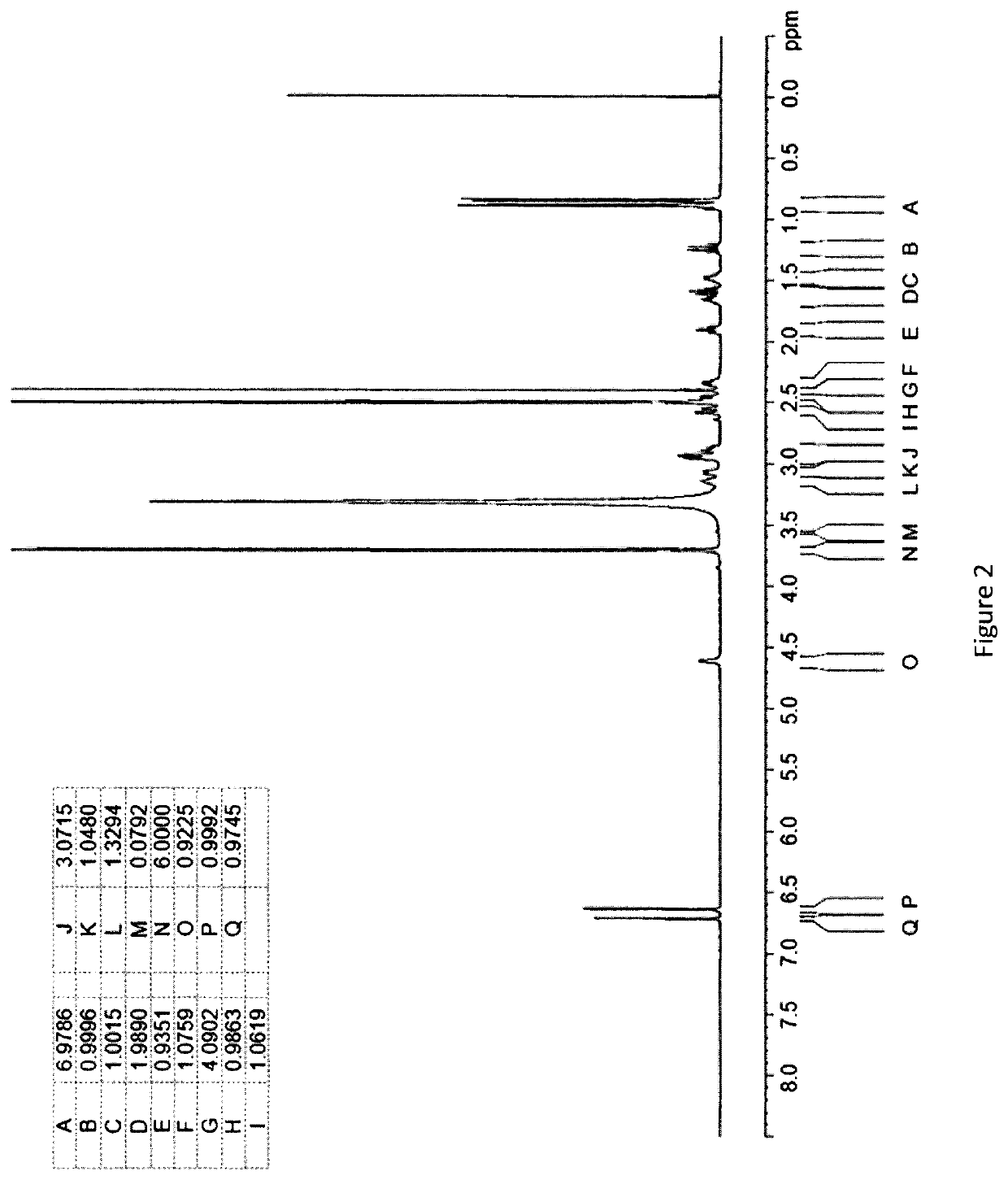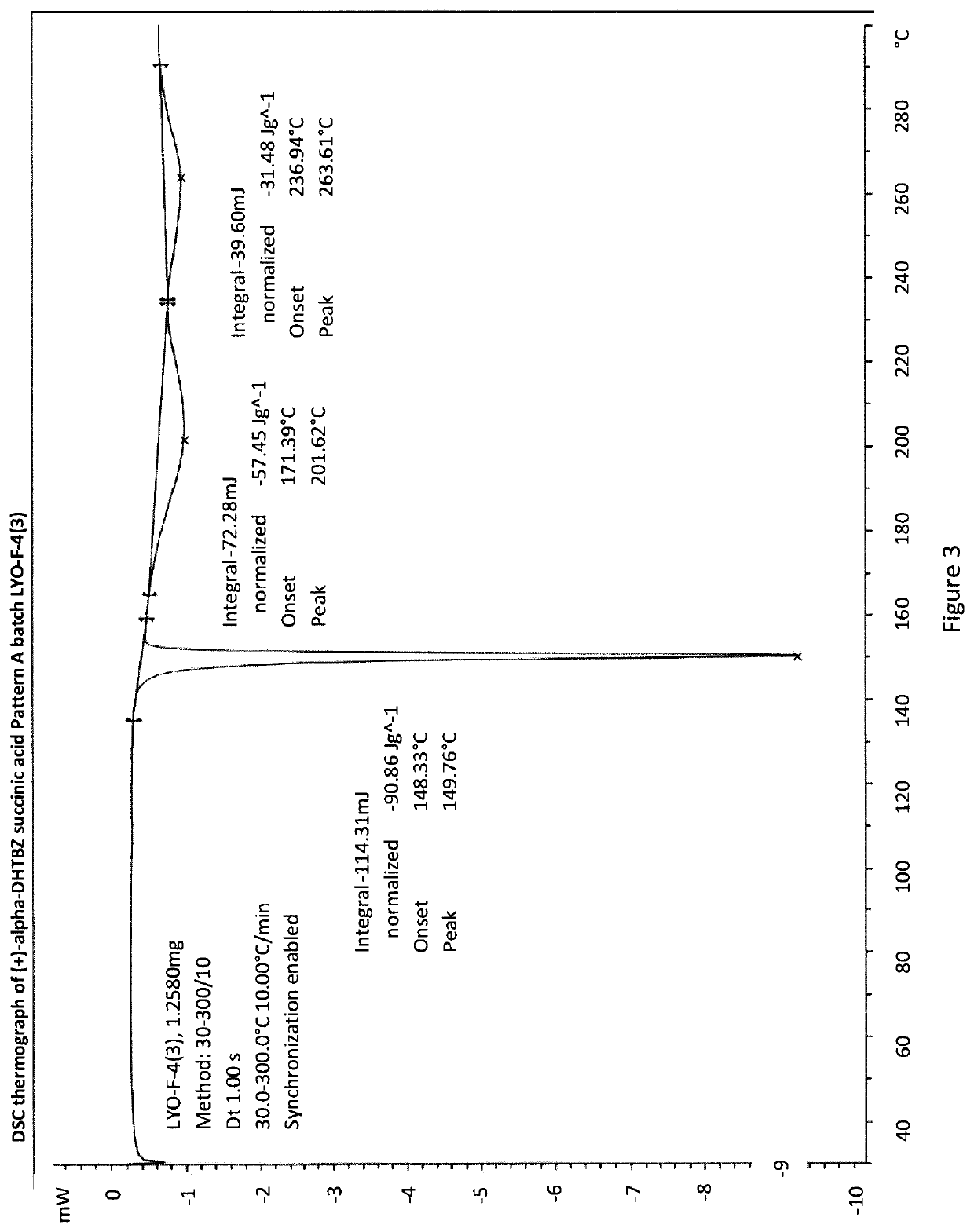Pharmaceutical compositions
a technology of pharmaceutical compositions and compositions, applied in the field of hyperkinetic movement disorders and hypokinetic movement disorders, can solve the problems of tremors, dystonia, abnormal and/or excessive movements, etc., and achieve the effect of suppressing tics, avoiding tremors, and avoiding tremors
- Summary
- Abstract
- Description
- Claims
- Application Information
AI Technical Summary
Benefits of technology
Problems solved by technology
Method used
Image
Examples
example 1
An Investigation into the Ability of 2R,3R,11bR-dihydrotetrabenazine to Form Salts
[0311]Experiments were carried out to assess the ability of (+)-α-dihydrotetrabenazine to form acid addition salts from a variety of mineral and organic acids. More specifically, attempts were made to prepare salts of (+)-α-dihydrotetrabenazine with hydrochloric acid, sulphuric acid, phosphoric acid, L-tartaric acid, citric acid, L-malic acid, adipic acid, methanesulphonic acid, succinic acid, benzenesulphonic acid and naphthalenesulphonic acid. In a first experiment, solutions of (+)-α-dihydrotetrabenazine (32 mg / ml) in either ethyl acetate or acetone were prepared and divided into 1 ml aliquots, each of which was introduced into a 4 ml glass vial equipped with a stirrer bar and the temperature of the solution maintained at 50° C. using a J-KEM heating block. An acid (1.05 molar equivalents) dissolved in dioxane or aqueous dioxane was then added in a dropwise manner. Following addition of the acid, th...
example 2
Further Characterisation of (+)-α-dihydrotetrabenazine Salts
[0316]Based on the studies described in Example 1, the succinic acid, hydrochloric acid, sulphuric acid and benzenesulphonic acid salts were selected for further characterisation.
2A. Hydrochloride Salt Form A
[0317](+)-α-Dihydrotetrabenazine free base (30 mg) was dissolved in acetone (1 ml) at 50° C. in an 8 ml vial and 0.225 ml of a 0.5M solution of hydrochloric acid in either water or a 1:7 dioxane:water mixture (corresponding to 1.1 molar equivalents relative to the free base) was added dropwise with stirring to the vial. The vial was cooled slowly to ambient temperature and stirred overnight. The resulting solution was then evaporated to dryness under a gentle stream of nitrogen. Acetonitrile (0.5 ml) was added and the mixture was stirred to form a slurry. After three days of stirring, the resulting solids were isolated by centrifuge-filtration and dried at ambient temperature under reduced pressure to give (+)-α-dihydro...
example 3
[0344](+)-α-Dihydrotetrabenazine in amounts was administered by oral dosing to five human volunteers. In four of the volunteers, blood sample were taken at 30, 60, 120 and 180 minutes after drug administration. Blood samples were not taken from the fifth volunteer. At 60 minutes after drug administration, PET scans were initiated and these were stopped at 120 minutes after drug administration.
[0345]The experiment was carried out at dosages of 7.5 mg, 15 mg and 22.5 mg.
Results
[0346]Table 1 shows the plasma concentrations in nanogrammes / ml of (+)-α-dihydrotetrabenazine in 4 human subjects, 0.5, 1, 1.5, 2 and 3 hours after a dose of 7.5 mg, 15 mg and 22.5 mg. Table 2 shows the % VMAT2 blocking following administration of 7.5 mg, 15 mg and 22.5 mg of (+)-α-dihydrotetrabenazine in all five subjects.
[0347]
TABLE 1Subject #Time (h)12345Body112761295991Weight(kg)Dose(oral) 7.5 mg0.5BLQ0.5310.2168.43ND10.9413.74.3515.0ND1.52.3910.86.9120.7ND22.4414.05.0317.6ND33.0122.26.9619.6ND 15 mg0.54.02...
PUM
| Property | Measurement | Unit |
|---|---|---|
| diffraction angles | aaaaa | aaaaa |
| diffraction angles | aaaaa | aaaaa |
| diffraction angles | aaaaa | aaaaa |
Abstract
Description
Claims
Application Information
 Login to View More
Login to View More - R&D
- Intellectual Property
- Life Sciences
- Materials
- Tech Scout
- Unparalleled Data Quality
- Higher Quality Content
- 60% Fewer Hallucinations
Browse by: Latest US Patents, China's latest patents, Technical Efficacy Thesaurus, Application Domain, Technology Topic, Popular Technical Reports.
© 2025 PatSnap. All rights reserved.Legal|Privacy policy|Modern Slavery Act Transparency Statement|Sitemap|About US| Contact US: help@patsnap.com



